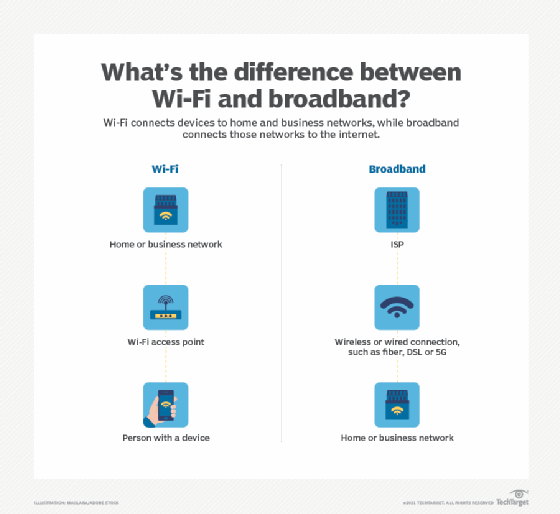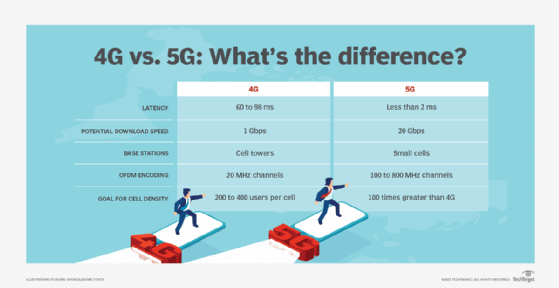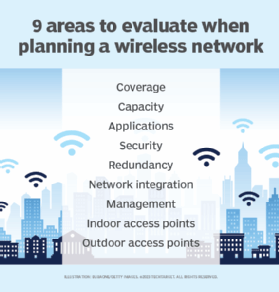wireless broadband (WiBB)
What is wireless broadband?
Wireless broadband (WiBB) is a high-speed internet and data service delivered through a wireless local area network (WLAN) or wireless wide area network (WWAN). As with other wireless services, wireless broadband may be either fixed or mobile.
The term broadband generally refers to relatively high-speed internet access. It includes several high-speed transmission technologies such as cable modems, fiber, satellite and wireless. Wireless broadband speeds are defined by the FCC to be at least 25 megabits per second (Mbps).
Wireless broadband provides high-speed wireless internet or computer networking access over a wide area. The advantage of wireless broadband over other broadband types is that wireless broadband connections don't need to be physically tethered to a modem or router. Conceptually, think of wireless broadband as using a smartphone hotspot to provide internet service, but with dedicated equipment.
Wireless broadband is used in homes, businesses, internet cafes and other places. Internet service providers (ISPs) usually sell mobile broadband to consumers through a paid subscription to access the service. Generally, free municipal broadband or Wi-Fi would not be considered mobile broadband, even though it provides a similar service. With wireless broadband, an ISP usually provides the service over a wide area to many customers. A modem is used to connect to the provider's wireless network, with most modems linked to a single provider.
Wireless broadband is not the same as Wi-Fi, which is a way to connect computers and devices together into a LAN, and may be used to connect a network to the internet by another means. Wireless broadband implies that internet service itself is being delivered wirelessly to a single device, which may, in turn, be connected to other devices -- possibly using Wi-Fi or Ethernet.

How does wireless broadband work?
For an internet connection to qualify as broadband in the United States, it must offer at least 25 Mbps download and 3 Mbps upload, as defined by the FCC in 2015. The United Kingdom considers 10 Mbps download and 1 Mbps upload as broadband speed, and 24/30 Mbps is superfast broadband in both the UK and EU.
Wireless broadband requires a wireless transceiver and wireless router or modem. A broadband service is also required as a continual expense. Wireless broadband connects homes and businesses to the internet, transmitting radio waves between the user's location and the service provider's location.
Wireless broadband is typically divided into either fixed or mobile categories, determined by whether the connecting device is fixed in a single location or can be easily moved. A mobile connection would be in a cellphone, laptop or a dedicated mobile hotspot and fixed wireless service would be a device designed to provide internet to an entire home or office.
For mobile wireless broadband, high-speed internet is delivered wirelessly by an ISP to the customer and is commonly called wireless internet, broadband wireless or cellular internet. In this context, broadband is used as a shorthand way to refer to high-speed internet connectivity.
Fixed wireless may be a standalone device with only an Ethernet jack to connect it to another network or -- as with many modems today -- multi-use devices with a router and Wi-Fi access points built in. It may use an external antenna to provide better connectivity to the provider's base station, and it may be physically mounted to the building structure.
Many of these antennas are directional, providing better reception if pointed at the service tower. Some services require (or have better performance with) a line of sight to the tower. Therefore, trained equipment installers may be required. Fixed wireless speeds may range from 100-300 Mbps.

Features of wireless broadband
Features of wireless broadband may include the following:
- Download/upload speeds. Download speeds differ per region and country; however, the minimum speeds in the U.S. and the EU, respectively, are 25 and 24 Mbps. Currently, in the United States, mobile wireless broadband averages 79.2 Mbps for downloads and for 9.29 Mbps uploads, while the global averages are 37.98 Mbps download and 9.75 Mbps upload.
- Range. The range of a wireless broadband signal is commonly about 31 miles from a nearby tower.
- Symmetrical/asymmetrical data rates. Some service providers will offer the same upload speeds as download speeds, while others may offer higher download speeds.
Because wireless broadband transmits through radio waves, it is also recommended to use a firewall and a secure password to help protect against unauthorized access.
Business considerations for wireless broadband
When starting to plan or consider the use of wireless broadband, teams should also consider the following:

- Coverage. Coverage refers to the geographic location that receives wireless access. Organizations with large or distributed locations have more coverage requirements.
- Capacity. Capacity refers to how much traffic a wireless network can support, considering speeds, latency and bottlenecks. Network teams should estimate their organizations' expected growth, find out how many users are currently on the network and approximate how many might join in the near future. This helps network teams determine the types of clients the wireless network needs to support, bandwidth expectations, how many access points are needed and data rates.
- Applications. Network teams should ensure the network is aligned with mission-critical applications and workflows.
- Security. Take steps to secure the wireless network. Teams should investigate security features like wireless intrusion prevention and detection, two-factor authentication, role-based access control and firewalls.
- Redundancy. In the case where something goes wrong with the network, teams should have backup options.
- Network integration. This helps teams pinpoint end-to-end network visibility and integration needs.
- Management. Teams should also consider how a network management platform handles the different network components.
- Indoor or outdoor access points. Indoor access points are typically installed on walls or ceilings and are not waterproof, while outdoor access points are designed to withstand the outdoors and cover the outside premises of a location.
Cellular wireless broadband
Cellular wireless broadband is high-speed internet delivered by a cellular telephone network. The signals are sent and received by a cellular base station that wirelessly transmits to the consumer's modem. The signal is then either embedded in a device, like a cellphone, or a separate device that is connected to a home computer or network. Cellular wireless is the most popular form of mobile broadband.
Using a cellphone network for internet access has advantages and disadvantages. Modems are cheap and readily available, and cell range is usually good, covering most geographic regions. Some rural areas may be too far away from towers, however, and not have high-speed service.
Many devices from many different people connected to a single tower can cause slowdowns, congestion and loss of service, and most service plans have relatively low data caps, which limit their usefulness or make them expensive to use for multiple devices. Furthermore, cellular wireless broadband plans without data caps will throttle performance down considerably once a certain usage threshold has been reached.
Modern 5G New Radio (5G-NR) technologies make using wireless broadband as a primary home internet connection more viable than in the past. Advances in cellular wireless technology and the underlying networks reduce many of the connectivity issues with traditional 4G LTE mobile broadband.
5G-NR offers extremely high speed in urban areas, rivaling dedicated fiber links without running cabling to every apartment. It also allows for lower wavelength signals than 4G, which can provide high speed over longer distances for better service in rural areas. The increased spectrum capacity also reduces issues with network congestion.
Other types of wireless broadband
WiMAX is a dedicated wireless broadband technology that's similar to Wi-Fi but uses different equipment. Devices that connect to a WiMAX signal are known as subscriber stations.
WiMAX covers an area greater than Wi-Fi but less than a cellular data connection. Conversely, possible data speeds are higher than traditional 3G cellular data, but slower than Wi-Fi. It has seen adoption in Europe, Australia and other areas as a popular way to provide last-mile internet access to homes, but has not experienced widespread adoption in the U.S.
In practice, 4G LTE has eclipsed WiMAX for consumers, and 5G-NR will be completely superseded by 4G LTE. WiMAX still sees some use in metropolitan area networks, industrial applications and for large area networks such as at airports, however.
Several other technologies can provide wireless broadband service, but do not have widespread adoption or have been phased out in favor of newer technologies. They operate in the microwave radio spectrum:
- Local Multipoint Distribution Service (LMDS).
- Multichannel Multipoint Distribution Service (MMDS).
- Point-to-Multipoint Communication (P2MP, PTMP or PMP).
- General Packet Radio Services (GPRS).
Satellite internet technically falls into a wireless broadband category but is generally not classified as such.
Limitations of wireless broadband
Some limitations that may come with wireless broadband include the following:
- Data limits. Some services may come with data limits; however, users can normally choose a plan that offers different data rates.
- Signal consistency. If there are mobile network issues, a user's connection could stop working. Signal strength also weakens when the signal passes through thick walls or roofs. Bad weather might also weaken internet speeds.
- Security. Unauthorized access will narrow network bandwidth, slowing speeds.
Learn more about the history of wireless for business and take a look forward.





